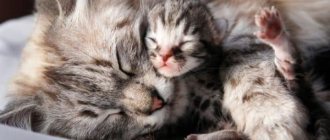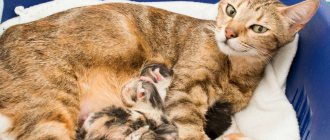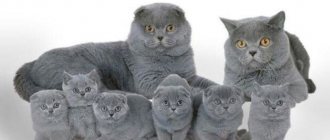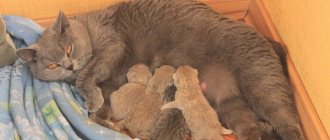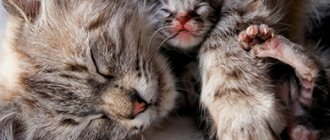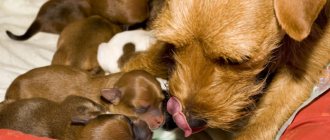Is it possible to feed Scottish kittens milk?
We will try to answer what care and feeding the Scottish Fold cat requires, formulating feeding rules in the following points:
Cats need a lot of water to digest, especially dry food. Therefore, do not let your pet feel its lack. Fresh water in a clean bowl should be visible.
How to feed properly is a question that causes a lot of controversy. But, perhaps, there is no one who disagrees with the fact that cheap food does not contain a composition suitable for food and health. The animal's interest in them is caused by taste enhancers and special additives that are addictive.
The Scottish Straight cat requires exactly the same nutrition as the Fold cat. The shape of the ears does not depend on nutrition.
The food must be either natural food or special food. Because industrial feed contains calculated nutrients for 1 serving. And for digestion, the body produces 2 different types of enzyme. Such food mixed in 1 meal will harm your cat’s gastrointestinal tract.
As a treat, you shouldn’t change the food manufacturer all the time.
Helpful tips for feeding Scottish Fold cats
- Do not add various spices, salt, pepper, sugar, stabilizers and other flavoring additives to your animal’s food;
- kittens should be given foods of liquid or puree consistency (you can use a blender for grinding);
- When feeding your pet fish or meat, thoroughly remove bones, including small ones;
- milk should not be given fresh, only boiled;
- a Scotsman's menu should be balanced and complete;
- It is necessary to feed the kitten only with warm food (room temperature);
- from 6 months, a Scottish kitten can be introduced to the diet in small pieces (useful for the proper development of the jaws);
- periodically pamper your beloved pet with seafood (shrimp, mussels, squid);
- during the winter season, when there is a natural lack of vitamins in the body, add a little fish oil to the kitten’s food;
- the Scotsman can sometimes be fed with a raw quail egg;
- be sure to include fresh and boiled vegetables in your daily diet;
- carrots should not be given often and in large quantities, as this vegetable can worsen liver function;
- To ensure that your pet enjoys eating vegetables and herbs, mix these products with meat, fish or ready-made broths;
- do not feed your Scottish kitten sweet foods, as they can cause the development of diabetes;
- marinades, smoked meats, coffee, spices and chocolate are real poison for your pet, do not allow these products into his diet!
Proper nutrition is the key to a long life for a Scottish Fold cat!
Selecting the power type
Every owner is faced with the question of what to feed Scottish Fold cats. The advice from veterinarians is that first of all, the owner must evaluate his time and financial capabilities.
Feeding natural and prepared foods is equally good. And only you can decide what is best to feed your Scottish. It doesn’t matter if you have a straight-eared or a fold-eared cat, make your food choices responsibly and rely on your pet’s preferences.
Natural food
Natural food is not food from the table, but products that completely replace commercial food for Scottish Folds in terms of the amount of nutrients, vitamins and minerals.
Cooking takes a lot of time, but you can be sure of the quality of what the animals eat. For cats, the menu should include sea fish (occasionally), lean meat (beef, chicken, rabbit), fermented milk products, eggs, low-carbohydrate cereals, vegetables, herbs, and vegetable oil.
Ready-made feed
To choose food for Scottish cats, you need to carefully study the basic composition, information about the manufacturer, reviews, then you will decide what is best to feed.
Super premium or holistic food is suitable as a cat's lunch. This can be wet or dry food.
Ready-made food brands such as Royal Canin, Akana, Fest Choice, Hills contain good quality meat and a large amount of vitamins.
Mixed diet
If you have not yet decided what to feed your Scottish Fold, then perhaps a mixed type of feeding will suit you. The advantages of such a diet are variety, the disadvantages are that it is difficult to determine the daily requirement.
It is also worth considering that the Scots love to eat and are prone to overeating. In addition, one feeding should not contain a mixture of natural and ready-made food. This can provoke various diseases.
Prepare food or shop
Preparing food for cats on your own is very difficult, as it requires precise adherence to the proportions of substances, so preparation takes a lot of time.
Usually those housewives who have a lot of free time and do not need to cook for the family feed “by hand”. It is especially dangerous to feed small kittens on your own, because their digestive system is not yet strong, and the body as a whole is weak, so they must receive all the substances, vitamins and microelements they need, which means that the cook requires deep knowledge in nutrition.
In this regard, ready-made feeds have a great advantage - they are completely balanced, they contain everything you need, and in the volume that is required.
Just don’t buy cheap ones - they have practically no meat, maximum skin, and in addition, there are many substances that have a negative effect on the animal’s body, but in our country they are used because it is profitable.
Important: European feeds, such as Shezir, do not contain harmful substances, since they are simply prohibited there. There is no need to listen to those who say that feed is made on the same equipment, and therefore they are supposedly the same. The equipment may be the same, but the raw materials that pass through it are very different.
How and what to feed a Scottish kitten
It is important to know how to feed a Scottish Fold kitten, especially if an addition has occurred in your family. Up to 1-2 months, breast milk remains the basis of feeding. If there is no milk, you can use the mixture. They contain the entire range of nutrients necessary for a kitten.
Until three weeks of age, the baby needs to eat every 2 hours. At 1 month, Scottish kittens need food up to 5 times a day. The cubs need to be fed, gradually switching to adult food, starting with porridge, minced meat, and products chopped with a blender.
It is too early to feed a one-month-old kitten with ready-made food. But at 2 months old, a Scottish kitten can already be fed commercial food appropriate for their age. At the age of 2 months, it is time for Scottish kittens to become independent. They can be given to a new family or separated from their mother completely.
The average portion of a two-month-old kitten is 100-150 grams per day. You can give milk, goat or cow, after boiling it. When picking up a Scottish Straight from a breeder, ask what to feed the kitten at 2 months and what food he was given.
The menu at your family’s home should be the same as before, gradually changing over the course of 2 weeks. A Scottish Fold kitten should be fed in the same way as straight-eared cats.
At 3 months, cats undergo active growth and need additional vitamins and calcium. The meat can be cut into larger pieces; the little cat’s teeth are strong enough. You can feed him good ready-made food or give him mixed food.
For a 4-month-old kitten, greens are included in the diet to help remove hairballs. Babies eat less often, but the food must contain enough protein for growth. At 5 months he is already a teenager and eats meat in any form.
Low-fat sea fish can be given once a week. Before a year, the animal will turn into an adult, the cats reach sexual maturity, the number of feedings is reduced to 2 times a day.
The Scottish Fold is a breed widespread throughout the world. Cats have an unusual appearance - the tips of their ears are lowered forward and downward, which was caused by a gene mutation. If you choose this breed, then it is important to know how and what to feed your Scottish Fold kitten. Proper nutrition is the basis for good health of an adult animal.
Until what age should kittens be fed milk?
Usually it is given up to 2-3 months, that is, until the age at which kittens stop suckling from the mother cat's breast. At the same time, it should not be very greasy, but not too watery.
Dilute it in a bowl, put it in a syringe and drop it on the kitten’s tongue so that it licks it. If your budget allows, then you can buy ready-made milk at the pet store especially for small kittens, in which the proportions of vitamins, minerals and trace elements are observed.
Of course, this is not cat’s milk, but cow’s or goat’s milk, just in laboratory conditions, it was brought to the desired consistency. It's not cheap, but considering that you won't have to buy it for a long time, you can be patient.
Breed Features
The Scottish Fold, or Scottish Fold, is a naturally occurring breed. A cat with curled ears was born in Scotland and gave similar offspring. Then breeders began breeding the breed. Now folds can be found everywhere.
Adult Scottish Folds are medium sized, strong built, with thick, soft fur. It can be of different colors: plain, with a pattern or white splashes.
Scottish Folds are friendly, unpretentious in feeding and care, and very attractive in appearance. These qualities allowed the Scots to fall in love and spread along with British cats.
Features of the breed that determine the principles of feeding:
- Fold-eared Scots appeared naturally, in natural conditions. This influenced the preservation of predatory instincts among modern Scots. Therefore, the basis of the diet should be meat products.
- Formation of the jaw and replacement of teeth. This process occurs during the first 6 months of life. Oral hygiene comes to the fore. During this period, food should be soft so that the kitten can chew it comfortably. If feeding occurs incorrectly, the following symptoms will be detected: salivation, unpleasant odor, yellowing of the enamel, formation of tartar, swelling of the gums.
- Tendency to obesity. Scottish Folds can quickly gain weight if they are overfed. Therefore, it is important to follow the feeding regime and not exceed the daily calorie intake. At an early age, this is not a threat, since kittens are very active and playful, so calories will be spent on replenishing energy, growth and development.
- Susceptibility to diseases: constipation, bladder stones, heart pathologies. This leads to the fact that the diet must be balanced in nutrients and nutrients. It is important to pay attention to prohibited products.
- Late development. Scots, unlike wild breeds, develop more slowly, which affects the first feeding. The optimal period for introducing solid food is 1 month.
- The importance of diet choices. The psychological characteristics and health and appearance of an adult animal depend on the first feeding. Thus, with the introduction of meat products, kittens will learn hunting skills earlier and develop dexterity.
Nutrition is an important condition for the normal growth and development of Scottish Fold kittens. It must be balanced, designed for the needs of a growing organism. When feeding, it is important to take into account breed characteristics in order to avoid health problems for your pet.
Choosing a place and dishes
Before purchasing a kitten, the owner needs to arrange a place where the pet will feed. Although the Scots are unpretentious, this is worth paying attention to. Therefore, choosing a place and utensils is no less important than feeding itself.
Containers for water and food must be stable and spacious. The minimum number of bowls is two pieces. However, with mixed feeding, you will need to purchase one container for each type of food and water.
Common bowl materials:
- Ceramics and faience. This option is considered optimal for Scottish kittens. The dishes are heavy, so they will not slide on the floor. Other advantages include: the ability to wash well and the lack of tendency to retain odors that can affect water and feed.
- Metal. Bowls made of this material are usually made on a stand or with an elastic band along the bottom rim, which prevents movement and sliding on the floor.
- Plastic. Main advantages: lightness of the dishes, stability, variety of shapes and sizes. However, there are also significant disadvantages - food residues getting into the cracks and retaining odors. Because of this, it is recommended to change plastic bowls frequently. External characteristics for suitable dishes are a wide diameter, low sides so that the bowl is not very deep. A container with a volume of up to 0.5 liters is suitable for food; you can take more for water.
The arrangement of the place is carried out taking into account behavioral characteristics.
- placing bowls next to each other; a permanent place for feeding, which will help the pet get used to it faster; placing a rug or tray under the dishes so that the bowls slip less and the floor does not get dirty.
The optimal place is a separate corner in the kitchen, away from noisy furnishings and bright light. The dishes must be washed at least once every 2 days, preferably without the use of detergents.
Remember! You should not wash cat bowls in the same place as human dishes, as animals often carry parasites.
What to feed a Scottish Fold kitten
When bred by amateurs, Scottish Folds are often prone to food allergies, so nutrition plays a leading role in the proper development of pets. Before purchasing a representative of this breed, it is recommended to study what to feed a Scottish Fold kitten.
There are 3 types of diet to choose from:
- natural feeding – a diet of ordinary foods approved for cats. It is considered a classic, has its pros and cons. The main advantage is diversity; ready-made food - a diet based on industrial nutrition, including dry granules, wet and semi-moist food. When choosing, you should pay attention to the class - Premium and Super-premium are acceptable for the Scots; mixed diet - a combination of natural products with ready-made feed.
Veterinarians do not advise choosing the third type of diet, since eating different foods together will lead to digestive problems and decreased absorption of vitamins, minerals, and nutrients.
Natural diet
A natural diet is a classic type of food for cats. The introduction of solid foods begins gradually, after reaching one or two months.
List of products for kittens:
- Meat – lean beef or veal, chicken, rabbit, turkey. It is given boiled, but sometimes it can be raw, but only frozen. Offal – necks, hearts, navels. Allowed for 4–6 months. Liver is given rarely, no more than once a week, and only boiled. Sea fish of fatty varieties - pink salmon, chum salmon, salmon, trout. It is saturated with healthy fatty acids. It is allowed to give no more than once a week, after light boiling. It is better to take boneless fillet. Dairy products – whole milk (only boiled for up to 3 months), fermented milk products. Kefir, fermented baked milk, and cottage cheese enriched with calcium are suitable for kittens. Dairy products should not be given frequently as excess calcium will cause the ears to straighten. Eggs – chicken, quail. The optimal portion is 1 yolk per day, if quail eggs, then 2-3 yolks. Can be given as an omelet with a little milk and no butter. Cereals – buckwheat, rice, millet. Served in the form of porridges mixed with meat, minced meat or fish. Cereals are a supplement and should not be given on a regular basis. Vegetables, greens, fruits - zucchini, cauliflower, green beans, apples, pears, grass. It is recommended to give grated, crushed or pureed. Vegetable oils – olive, flaxseed, sunflower. The daily portion is half a teaspoon in porridge or vegetables.
A natural diet has a number of features for Scottish Folds that need to be taken into account, for example, controlling the amount of calcium. Otherwise, feeding does not differ from that of other breeds.
- a variety of products whose price is lower than high-quality industrial feed; confidence in freshness and quality; development of predator instincts; the ability to monitor reactions to foods, which helps identify food allergies.
- the need for constant cooking; short shelf life; lack of confidence in the balance of the diet in terms of nutrients, vitamins and minerals.
Feeding with natural products is chosen by most new owners. If you don’t have time to constantly prepare food, then this diet is not suitable. The main feature is the addition of vitamin and mineral complexes to food.
Prepared feeds are industrial products. Manufacturers produce them, adjusting them to the needs of animals. The “kitten” line is suitable for small animals. Sometimes it is divided by age.
An important selection criterion is the feed class:
- Economy class food is made from low quality ingredients, with a minimum content of complete animal proteins. The basis is plant products. Economy food is not suitable for purebred cats.
- Feed Premium. The composition includes more meat products, but plant ingredients predominate. The products are saturated with useful substances. Premium food is suitable only in case of normal tolerance. If there are health problems, then a higher class is necessary.
- Super premium feed. The main part of the ingredients are meat products with a complete protein composition. Plant components are represented by vegetables and cereals. The feed is enriched with taurine, vitamins and minerals. Super-premium - the best food for Scottish cats.
Industrial cat foods are divided into wet, dry and semi-moist. Dry granules are introduced into the diet when kittens are almost adult. Wet and semi-moist foods are necessary during the transition period between mother's milk and solid food.
- ease of use; balance in all components; wide range to suit your pet's needs; storage duration.
- high price; the likelihood of buying a fake; information falsification - a discrepancy between the actual composition and what is on the packaging.
Ready-made food is the best option for purebred cats. They are more susceptible to various diseases, and the line of industrial products provides a choice for a specific situation. For example, hypoallergenic foods are common.
A mixed diet is a common type of feeding. However, according to veterinarians and breeders, it is not suitable for purebred cats, including Scots.
- Difficulty controlling calories and nutritional intake, which can lead to weight loss or obesity; the likelihood of developing digestive disorders; the need for periodic intake of vitamins and feed additives.
If a mixed diet has been chosen, then it is recommended to follow the main rule - do not mix natural food with ready-made food. This is due to differences in digestion.
Adult pet diet
The structure of the digestive system of all cats is not particularly different, therefore, for an adult cat from the Scottish Fold and Straight-eared species, the food does not differ in composition. The main thing is to provide your pet with a varied, high-quality and balanced diet.
Table No3. Diet of an adult Scottish Fold or Straight-eared cat.
Dry and wet food
Ready-made food from manufacturers of dry and wet products has the following advantages:
- Convenient for feeding, it is produced in production in the form of mixtures: - pastes, pieces of jelly, canned food and dry pads. Doesn't take much time to cook.
- The composition fully takes into account the cat’s need for a complex of beneficial substances for the body with the addition of vitamins, minerals, and herbal ingredients.
- For each type of product, a dosage of the daily amount required for a balanced diet has been developed.
- The mixtures include natural products processed using a special technology that ensures long-term storage.
Food is produced in different categories: holistic, super-premium, premium, economy class, consistent with the age of the kitten.
The finished food is easily digested by the animal’s body and is eaten with pleasure.
When switching Scottish cats to ready-made food, you must adhere to the following feeding rules:
- Choose only high-quality food for feeding Scottish fold and straight-eared purebred cats: holistic, superpremium, premium class.
- Strictly follow the manufacturer's recommended daily or single dosage of the product indicated on the packaging.
- You can feed your pet in two modes:
- One-time, once a day, the entire amount of food is laid out in a bowl. So, it’s convenient to feed your pet for busy owners.
- Portioned, the entire daily dose is divided into shares and given to cats according to a time schedule. More useful for the cat, there is no threat of obesity.
- The animal is constantly provided with free access to water. Use bottled liquid and replace it with fresh one daily.
Important! It is advisable to decide what kind of food is best to feed your pet and choose products from one manufacturer that are age-appropriate. This will ensure control over the supply of nutrients in food.
Recommended food from finished product manufacturers for Scots: Royal Canin, Hill's Science Plan, FLATAZOR CROCKTAIL, Sanabelle.
Table No. 4. Popular companies producing cat food.
Natural nutrition
There is no doubt about whether it is worth feeding a Scottish kitten regular food and what food is best for kittens. Tasty, fresh food, natural in composition, close to the natural nutrition of animals. Properly selected food prepared from a variety of products will please your baby. When eating natural foods, vitamin complexes are additionally included in food.
Important! Breeders and veterinarians believe that natural products are much healthier than ready-made branded products in the form of canned food, pouches and dry food.
For the owner, daily cooking creates certain difficulties and requires a lot of time. Many people cut up a large complex amount of food in advance, including meat products, vegetables, eggs, herbs, for a week. The entire prepared mass is laid out in portions into bags and frozen. Use daily, giving to the pet after heating.
There are two power modes:
- Constant, when the daily amount of food is immediately placed in a large bowl. And the pet eats everything as desired. This regime is convenient for busy owners, but there is a risk of cat obesity.
- Portioned, when food is given out in small quantities several times a day, the cat gets used to not overeating, which is good for his health. This makes feeding convenient for those who are constantly at home and can maintain an hourly schedule.
Important! The natural nutrition basket of the Scottish fold and straight-eared cats consists of meat, vegetables, fermented milk, eggs, herbs and other products. Occasionally, you can pamper your pet with fish, seafood, and fruits.
is it possible to give milk
It is not recommended to give milk to adult cats due to the high lactose content. It can be replaced with fermented milk products as a source of calcium. Particularly important is low-fat cottage cheese, which is given 2 times a week, on other days kefir and fermented baked milk.
Meat
Meat is an obligatory daily product in the diet; its daily content makes up up to 70% of the total food. Scottish cats, known as mousecatchers, benefit from raw meat. It is well frozen in advance to get rid of parasites. Meat products include: beef, chicken, all other types of poultry except fatty breeds. All types of offal: stomachs, liver, heart, kidneys. The meat is cut into large pieces so that the pets develop jaws and sharpen their teeth.
Fish
Fish and seafood are very beneficial for cats, necessary for the growth and strengthening of bones. Low-fat varieties of any sea fish: hake, pollock, perch and other types are freed from bones and scalded. Included on the menu infrequently: 1-2 times a week. It is not recommended to give river fish, it is very bony and can damage the stomach.
Porridge
Buckwheat, barley, wheat, pearl barley, oatmeal porridge. They are cooked until fully cooked in water or milk, add a few drops of vegetable oil: Olive, flaxseed, sunflower. Porridges are mixed daily with meat, fish, and vegetables in a ratio of 1:3 of the total volume. Do not add salt or sugar. Recommended as complementary food for kittens from 5 months.
Sample menu by age
Kittens grow, get stronger, and along with this their diet and feeding schedules change. To get out of the situation, it is important for the owner to know the approximate menu by age. For ready-made food, portion sizes and number of feedings are indicated on the packaging. With a natural diet it is more difficult.
Up to a month
From birth to one month, Scottish kittens feed on their mother's milk. If the babies are left without a mother, then the owner feeds them using industrial cat milk substitutes, baby formula, or self-prepared formula.
Important! If the kittens are left without maternal feeding, then it is better to find a nurse cat for them. If this is not possible, then you will have to make every effort to fatten with substitutes.
1 month
Upon reaching 1 month, Scottish Fold kittens begin to be introduced to the first complementary foods. Here you can go in two ways: start with raw scraped meat (chicken, beef) or low-fat fermented milk products (ryazhenka, cottage cheese, yogurt).
Feeding with mother's milk or substitute continues. The total amount of food per day is 110–130 grams, meals – 7–8, can be changed depending on the needs of small pets.
2 months
At 2 months, the transition period begins - the kittens are gradually weaned from their mother or the amount of substitute consumed is reduced. Solid foods become more varied. Grated vegetables and bran are added to meat and dairy products.
After two months, the amount of food per day reaches 170–190 grams, 6–7 meals.
3 months
Kittens begin to be distributed at 3 months of age. This is a difficult period for pets, so you should approach feeding responsibly. New foods are added to the diet.
The basis of nutrition is not scraped, but finely chopped meat. Fermented milk products, vegetables, and fruits are introduced more actively in small quantities. At 3 months old, Scots can be introduced to cereals.
Amount of food – 230–250 grams per day, meals – 4–5.
4–6 months
At the age of 4–6 months, fish is gradually introduced into the diet - no more than 2 times a week. The meat is given in larger pieces. Greens are added to vegetables and fruits, preferably special grass, which can be purchased at a pet store.
The daily food intake depends on the size of the kitten. If it is large, then they give 310–330 grams, with medium sizes – 280–300 grams.
The number of techniques is reduced to three.
From 6 months to 1 year
The period from 6 months to 1 year is considered the completion of the development of a kitten into an adult animal.
The diet is as varied as possible, all permitted products are added.
The number of doses is reduced to two, the daily rate is also reduced and amounts to 5% of the animal’s weight.
Natural kitten diet
Kittens of the second month of life should still receive mother's milk along with complementary foods for some time. This is important for promoting good behavior and health. If the breeder weans the kittens from the nipple earlier, then later (after about six months) the first problems with friendliness and quality of digestion may arise, and it happens that such forms of behavior as sexual and territorial behavior are impaired due to milk underfeeding. It turns out how important it is to feed dairy kittens to their fullest.
After 3 months, when kittens are completely ready to feed on their own, the amount of cow's milk and its derivatives should be reduced. Cats often enjoy lapping up milk all their lives, but this is not always good for digestion, because... enzymes that break down milk protein cease to be synthesized.
In general, a kitten’s natural diet should include:
- Several types of meat;
- Ocean or sea fish;
- Eggs, cottage cheese, low-fat sour cream, kefir, a small amount of milk;
- A small amount of vegetables and fruits as a source of vitamins and coarse fiber (but how to get a cat to eat fruit?);
- Plant and animal fats, taurine, carnitine;
- A small amount of cereals as a source of plant fiber;
- Ready-made vitamin and mineral complex according to your needs.
It is not easy to balance all these components in the diet of a small, growing kitten whose nutritional needs are constantly changing. It is much easier to pay attention to the finished product. However, if the owner still wants to feed his cat food from the table, then as an alternative, veterinarians recommend using ready-made diets temporarily - at least up to 8-9 months. By this point, the period of intensive growth will end, and the kitten can be fed with the food that seems more acceptable to the owner. But still, it is better to choose ready-made food.
Something else interesting: Protein sources for cats - eggs
What not to feed a Scottish Fold kitten
List of what you should not feed your Scottish Fold kitten:
- products from the human table; legumes, some vegetables and fruits (avocado, potatoes, tomatoes, onions, broccoli, citrus fruits, dried fruits, grapes); whole milk, especially cow's milk; salted, smoked, fried, fatty, with many spices dishes; stimulants (chocolate, coffee, tea); sweets, confectionery, bakery products.
Feeding is an important part of the health, normal growth and development of Scottish Fold kittens. Breed characteristics change the general nutritional pattern for cats, which must be taken into account before purchasing a pet.
Is it possible to give Scottish Fold kittens milk (dairy products)?
I re-read the Internet on this topic and considering that my kitten loves milk, I give her milk diluted with water, 1/3 milk, 2/3 water, until her ears seem to stand up, but she is growing and it seems to me that her ears are a little taller from the fact that she has already become a little bit of a cat with us.
Kittens up to three to four months old can and should be given milk; babies digest lactose, unlike adult cats. The kitten is weaned from mother's milk, although cow's milk will not completely replace breastfeeding, but it will still fill the body with necessary microelements and vitamins, calcium, etc. Plus, it will delight the kitten with its taste; cats are big gourmets.
I myself have a teenage Scottishfold kitten, they gave me milk, now she is 6 months old, her ears hang as before. They can rise even in a kitten with a good pedigree, but not from milk, of course, just a game of genetics and nature, but they will not rise completely, of course. Although this may already disrupt the phenotype and make the animal unsuitable for exhibitions, this in no way depends on us.
Veterinarians do not recommend giving cats dairy products at all, as they are poorly digestible and may cause intestinal problems. They advise feeding animals exclusively balanced food. I believe that any food is much more harmful than milk or cottage cheese. And veterinarians recommend food solely because of advertising, since all veterinary clinics actively cooperate with food manufacturers and make a good profit from this. And employees of companies that produce these same foods very often conduct various seminars for veterinarians, at which they convince them of the usefulness of their products. The so-called belief occurs and people begin to really believe that this particular product is useful!
As for the breed, absolutely nothing depends on this! Imagine, for example, people. You were told that supposedly an American won’t get any pain from milk, unlike a Russian... This is nonsense. The structure of the body is the same for everyone, regardless of the nation (in your case, the breed of the animal). Only individual cases of intolerance are possible.
The most important thing is that if you start feeding your kittens human products, continue to feed them; under no circumstances should they be mixed with food! And if you prefer to feed with food, feed ONLY food; it is no longer advisable to give food from your table.
The kitten should be given pasteurized milk at room temperature or slightly warmed, low-fat cream. But an adult cat should not include milk in its diet, since it is poorly absorbed by the body and can cause diarrhea.
In fact, you can give milk, but not too liquid. It is best to add sour cream or cottage cheese to it. We always gave the kittens milk and there were no problems with it. But you still need to find out from the veterinarian in case your cat has milk intolerance. There is also an opinion that milk will make a kitty’s ears stand up. But I think this is nonsense.
You should give your kitten milk, preferably pasteurized, usually they digest it normally, but not all of it, and you need to look at the kitten’s reaction. For 1 kilogram of a cat's weight, give no more than 15 mg. milk, so it’s easy to calculate how much milk to give; if you give more, then you need to dilute it with water.
It doesn't depend on the breed of the kitten at all. Cats of all breeds should not be given cow's milk! It is not absorbed by their body. It's very greasy for them. At best, the kitten will have diarrhea and you will see for yourself that it does not suit him. And at worst, there will be hidden and more serious problems. You can give cottage cheese, for example, agushka.
Listen up, everyone, a kitten is a kitten, no matter what aristocratic breed it may be. All kittens drink milk, and if you are so worried, call your veterinarian, they obviously understand this and can give good advice.
Kittens should not be given milk at all; they may have problems with digestion and/or stool. It is best to use kefir or fermented baked milk for this complementary feeding. Kittens eat this delicacy with great pleasure and is healthy.
Useful materials:
General description of the disease Cutaneous horn on the forehead or face (ICD 10 code - L57.0) -...
Common causes of cloudy eyes in cats The most common causes of cloudy eyes are glaucoma, cataracts or keratitis.…
Main reasonsBefore considering the factors that provoke the appearance of discharge with a sourish odor, it is necessary to immediately note...
Normal temperature in different types of animals Veterinary services Day hospital for animals Veterinary certificates Vaccination…
Is it possible to give milk to a fold-eared kitten?
A real “urban legend” associated with milk concerns British and Scottish fold kittens. It goes like this: if you feed lop-eared kittens with cow's milk, their ears may “stand up.” The main argument in favor of this theory is that kittens will receive a lot of calcium from milk, which will strengthen the cartilage and straighten their ears.
This myth is used by unscrupulous breeders. In fact, Scottish and British kittens' ears may rise as they grow. This is due to a defect in the breed, or it can be considered a feature of a particular animal. Fallow cats must receive calcium and other minerals.
The answer to the question whether it is possible to give milk to a fold-eared kitten will be the same as for other breeds - cat milk is ideal, but cow, goat and sheep milk is not recommended.



